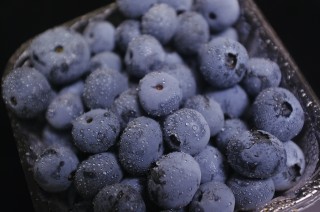Study Shows Flavor Trumps Health for Blueberry Buying

About 61 percent of blueberry consumers buy the fruit for its flavor, while 39 percent do so for psychological reasons, according to two national online surveys. By “psychological,” researchers mean those consumers may buy blueberries because they believe the fruit, which contains antioxidants, provides health benefits.
UF horticultural sciences assistant professor Jim Olmstead will use the data as he breeds new types of blueberries. Olmstead uses traditional breeding methods to create blueberry cultivars that have traits consumers want.
“What we’re trying to determine is: What is the consumer’s perception of the ideal blueberry? What should it look, taste and feel like?” said Olmstead, a faculty member with UF’s Institute of Food and Agricultural Sciences.
A company called Panel Direct Online recruited survey takers, using an online questionnaire to ensure participants bought blueberries in the 12 months before the survey and that they were evenly split between men and women.
Three hundred and six people answered the first survey, conducted in 2011. In 2013, the researchers surveyed another 300 blueberry buyers. Respondents in both surveys answered the same questions about six blueberry traits: firmness, texture, size, color, flavor and human nutrition. Researchers then divided traits into six more categories, so respondents revealed their preferences about 36 different blueberry traits.
Consumers valued such factors as “so sweet…no sugar added” and “bold and intense blueberry flavor” the highest. Also high on their list were “full of juice” and “full of antioxidants.”
Olmstead said his ongoing research includes improving blueberry texture, but survey respondents did not rate texture high on their list of preferred traits.
Using a nine-point scale, respondents were asked to rate their blueberry experiences, both good and bad. Respondents were tested on what scientists call psychophysics, or how your brain reacts to stimuli such as taste, smell and texture.
The survey used metrics designed by Howard Moskowitz, a psychophysicist who has helped companies, including Ragu, enhance flavors to meet consumer demand.
Florida blueberries generate $66 million annually, according to the Florida Department of Agriculture and Consumer Services. Native to North America, blueberries are now grown in South America, Europe, Asia and Australia.
Recent surveys by online grocer FreshDirect showed only 48 percent of U.S. consumers bought blueberries in the past year, compared with 88 percent who bought the top-selling fruit, bananas.
Historically, many blueberry traits have been selected with producers in mind, including climate adaptation, yield, harvest potential and disease resistance, said Thomas Colquhoun, an environmental horticulture assistant professor and study co-author.
Developing a new blueberry variety can take more than 10 years, so before investing that time, scientists and growers need to know what consumers want, he said.
“There’s not just one type of customer,” Colquhoun said. “You have purchasers that work with the sensory side of the brain, and then you have purchasers that work with the psychological side.”
Olmstead co-wrote the paper with Colquhoun, doctoral student Jessica Gilbert, former undergraduate student Laura Levin and professor David Clark, all in the Plant Innovation Program at UF/IFAS, and Moskowitz, a consultant in White Plains, N.Y. The paper appeared online in the July edition of the journal HortScience.
Downloadable broadcast video here: http://goo.gl/sdHDRH
See posted release: http://news.ufl.edu/archive/2014/08/ufifas-study-shows-flavor-trumps-health-for-blueberry-buying.html
Writer: Brad Buck, 352-294-3303, bradbuck@ufl.edu
Sources:
Jim Olmstead, 352-273-4837, jwolmstead@ufl.edu
Thomas Colquhoun, 352-273-4584, ucntcme1@ufl.edu
Media Contact
All latest news from the category: Agricultural and Forestry Science
Newest articles

New model of neuronal circuit provides insight on eye movement
Working with week-old zebrafish larva, researchers at Weill Cornell Medicine and colleagues decoded how the connections formed by a network of neurons in the brainstem guide the fishes’ gaze. The…

Innovative protocol maps NMDA receptors in Alzheimer’s-Affected brains
Researchers from the Institute for Neurosciences (IN), a joint center of the Miguel Hernández University of Elche (UMH) and the Spanish National Research Council (CSIC), who are also part of…

New insights into sleep
…uncover key mechanisms related to cognitive function. Discovery suggests broad implications for giving brain a boost. While it’s well known that sleep enhances cognitive performance, the underlying neural mechanisms, particularly…



